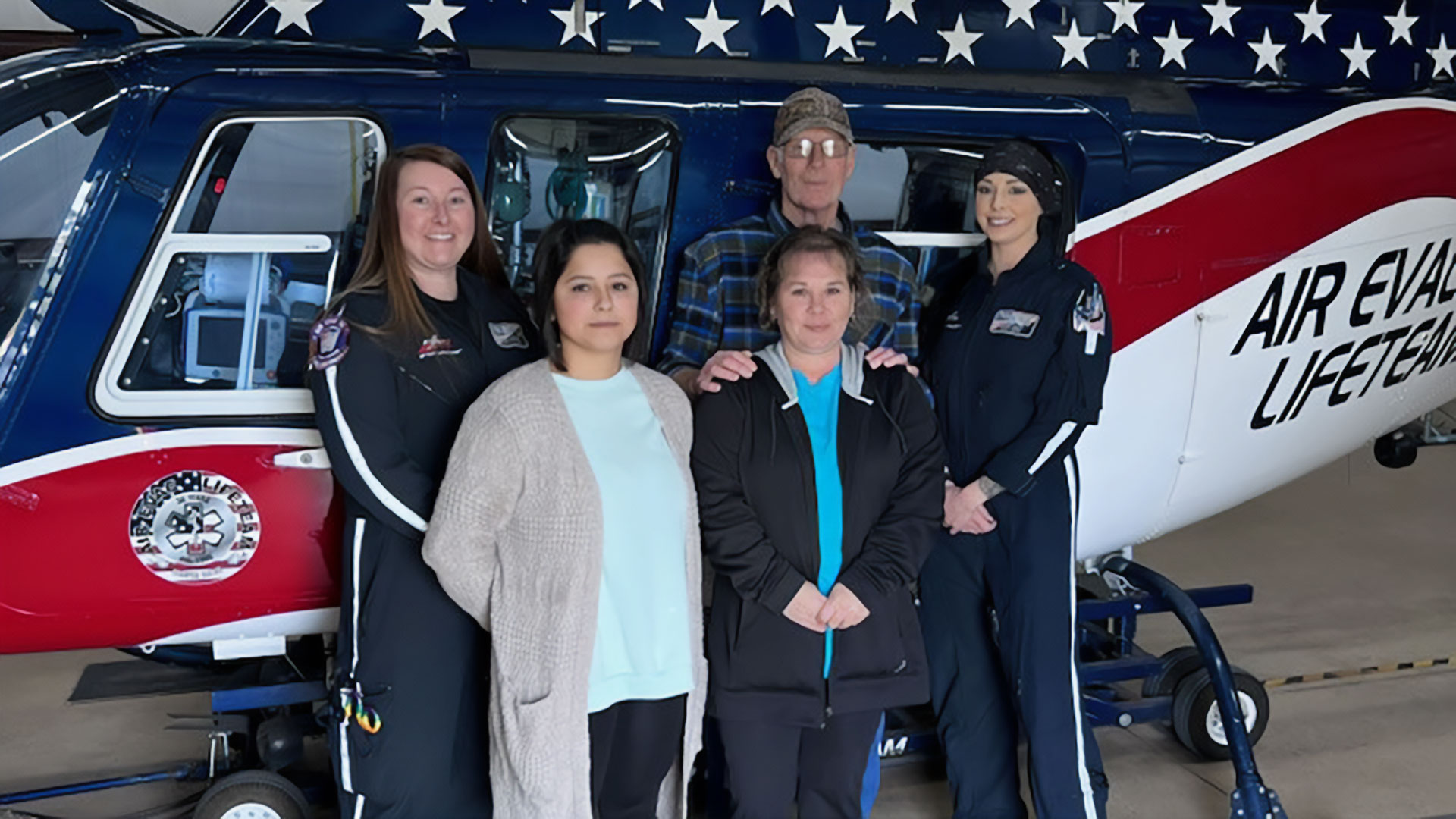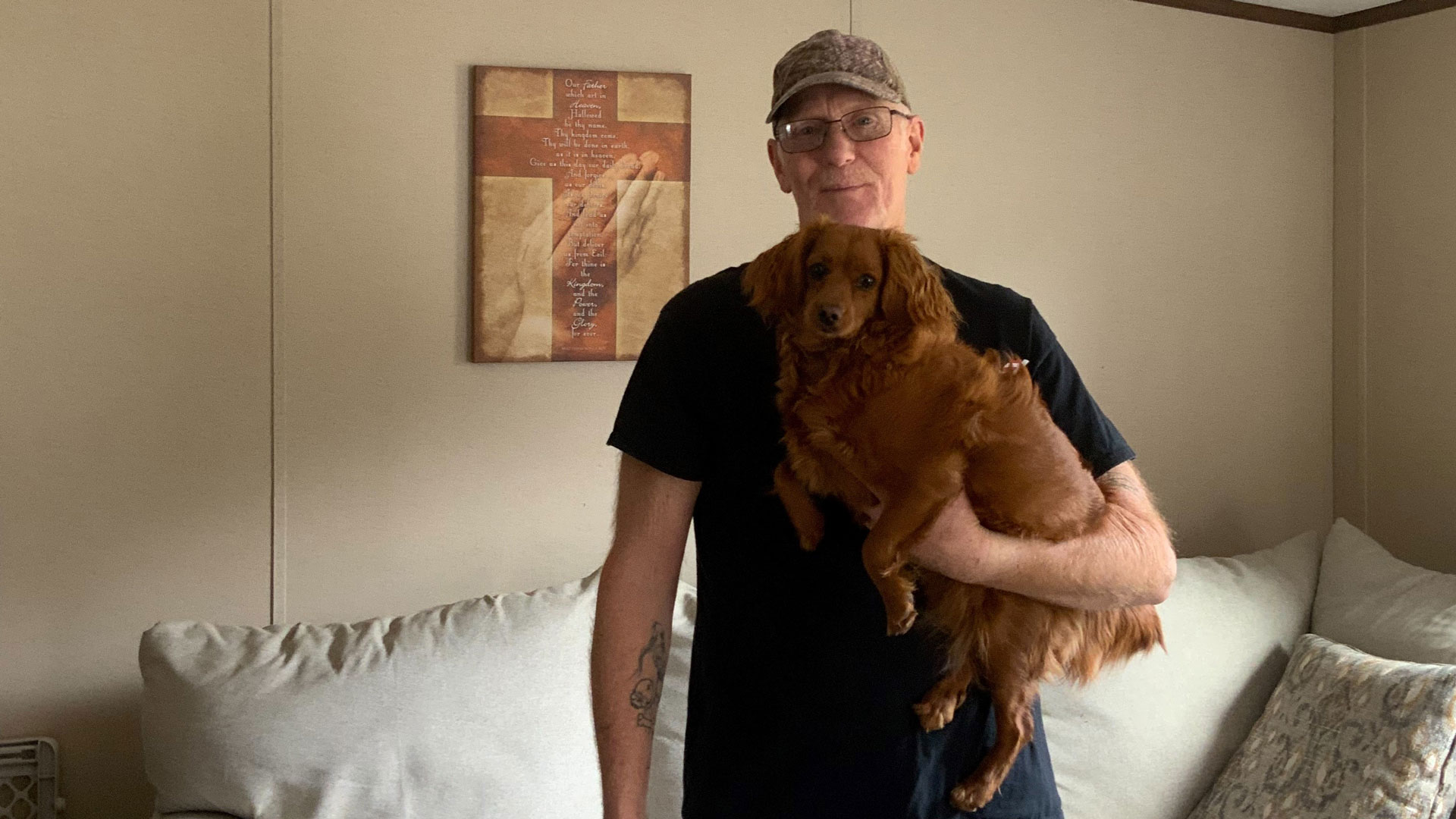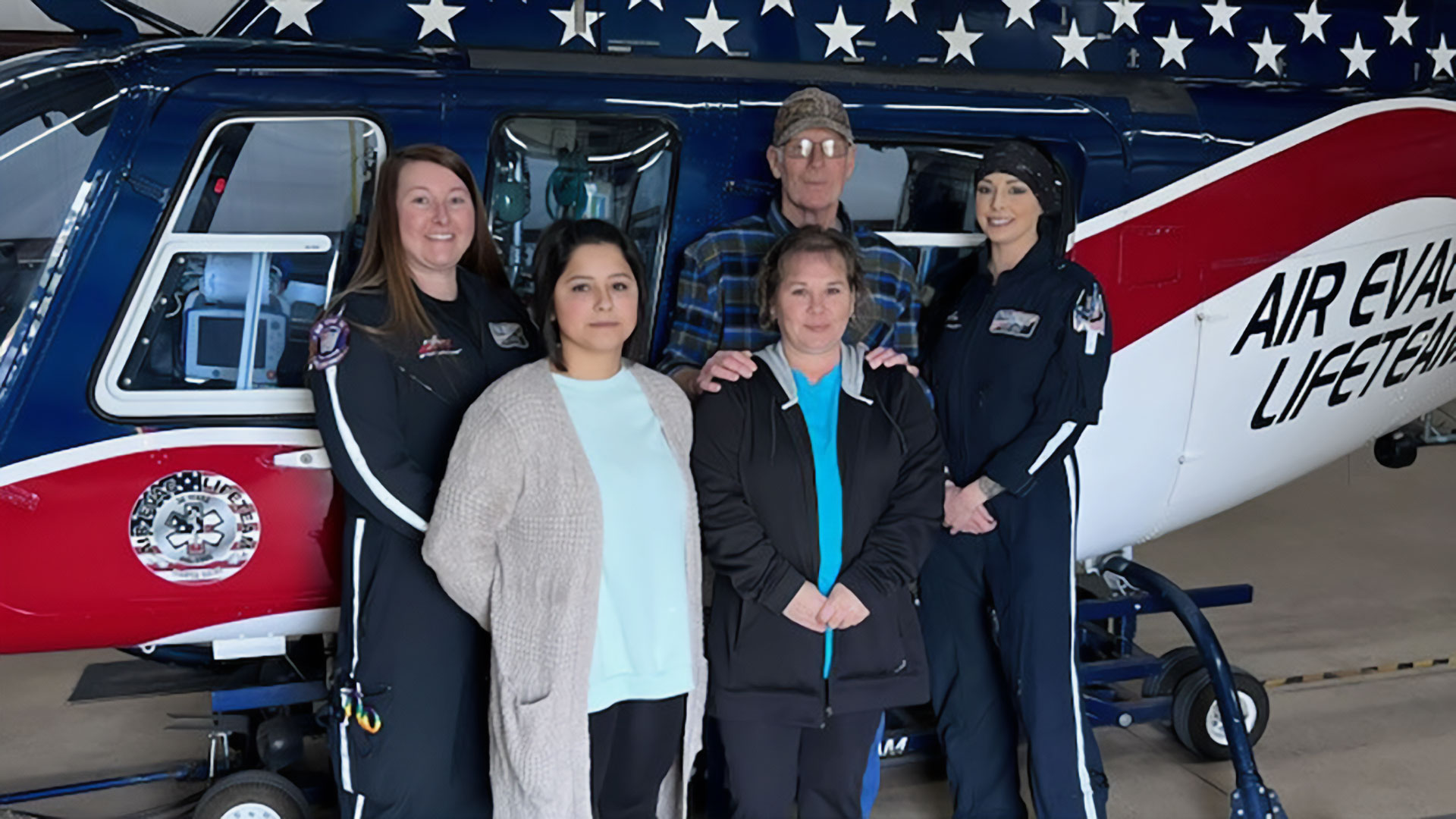A Split-Second Decision
March 17, 2023
A cardiac arrest patient in Kentucky says an AEL crew’s “quick thinking” saved his life.
We’ve all been there. We’ve just been informed of a situation that requires immediate action, but the problem is, we don’t have all the facts. Time is of the essence; lives are affected. What do we do?
For the medical crew of Air Evac Lifeteam (AEL) 092 in Breckinridge County in Kentucky, that question surfaced again one day in mid-September 2022, when the crew responded to a call of a man complaining of chest pains.
That “man,” Tom Hughes of Falls of Rough, an unincorporated community mostly located in Grayson County and a smaller part in Breckinridge County, remembers the event like it happened yesterday, largely because the choice made by the crew of AEL 092 is the reason, he believes, he’s still alive today.
“I was working on a pavilion for the patio of my house,” recalls Hughes. “I had worked on it for two hours when, all of a sudden, I started feeling a discomfort in my chest. I sat down, thinking it would go away, but the feeling only got more intense, so I called my wife. She helped me get back in the house and called 911.”
Grayson County EMS in Leitchfield arrived, but it soon became apparent to the paramedics that Hughes would need to be airlifted for advanced care. That’s when they called AEL and the air medical team took over.
“All the decisions Amanda [Grant, AEL flight nurse] and I made that day started on the way to the scene,” said Robin “Nicky” Langdon, AEL flight paramedic. “When I first looked at Tom, I knew he was sick; he was so pale and eerily calm. I immediately turned to Amanda and said, ‘we need to go.’ We both knew Tom was in trouble and could take a turn for the worst at any moment. So, we did a rapid assessment, got Tom on our monitor and left.”
Hughes doesn’t remember too much after that except for a few moments, including his transfer to the aircraft. “I remember looking up and seeing Amanda with her bandana on and thinking she looks like a female Rambo,” he said, chuckling.
Grant enjoys Hughes description of her, saying it “warms her heart,” and that it makes her happy that she could bring some comfort to a patient facing that kind of circumstance.
Hughes also remembers crew members talking amongst themselves on which hospital to take him to — a decision he says was made quickly and would prove to be critical in saving his life.
“They decided to take me to Baptist Health in Louisville instead of Norton Hospital, also in Louisville based on landing and timing reasons. If I went to Norton, they would have to land on the roof. At Baptist, they could land on the ground and could get me to the cath lab (cardiac catheterization laboratory) a lot faster than if they landed on the roof,” said Hughes.
However, as soon as the aircraft arrived at the hospital, there was a slight change in plans.
“When we landed at Baptist, the ER staff had a room waiting for us, so we didn’t go straight to the cath lab, as we had expected, and I’m glad we didn’t, because the hospital had extra staff and emergency equipment at his bedside, said Langdon. “While transporting him to his room, Tom looked at me and said, ‘I feel like I’m going to pass out’, and I remember telling him, ‘just hold on; we’re getting you on their bed and we’re going to help you.’”
It was there, in the ER, where Tom went into cardiac arrest. Fortunately, the ER staff were able to restore his cardiac rhythm, get a return of spontaneous circulation (ROSC) and, eventually, transfer him to the cath lab after he was stabilized.
Today, Hughes is a fully recovered and “grateful” man. The former smoker who “kicked the habit” now tries to follow a healthy lifestyle as much as he can. He also feels an overwhelming sense of gratitude for the AEL crew that got him the help he needed.
“They are heroes. I’m just a simple person who lives in a small town in Kentucky, and yet, here they are. They jumped in a helicopter to save me,” he says with an emotionally shaken and appreciative voice.
Hughes, who has visited Langdon and Grant and others at the AEL base several times, says he’s still amazed at how quickly the AEL crew could make a decision that would ultimately save his life. But for Langdon and Grant, that act was “business as usual” or a part of their job that they have to carry out every day.
“We are trained and taught to make these quick decisions as a team to provide the best outcome for our patients,” says Grant.
Langdon agrees. “Most wouldn’t understand, but when you look at someone and know that seconds will be the difference between life and death, that’s the driving force for all your decisions.”
For the medical crew of Air Evac Lifeteam (AEL) 092 in Breckinridge County in Kentucky, that question surfaced again one day in mid-September 2022, when the crew responded to a call of a man complaining of chest pains.
That “man,” Tom Hughes of Falls of Rough, an unincorporated community mostly located in Grayson County and a smaller part in Breckinridge County, remembers the event like it happened yesterday, largely because the choice made by the crew of AEL 092 is the reason, he believes, he’s still alive today.
“I was working on a pavilion for the patio of my house,” recalls Hughes. “I had worked on it for two hours when, all of a sudden, I started feeling a discomfort in my chest. I sat down, thinking it would go away, but the feeling only got more intense, so I called my wife. She helped me get back in the house and called 911.”
Grayson County EMS in Leitchfield arrived, but it soon became apparent to the paramedics that Hughes would need to be airlifted for advanced care. That’s when they called AEL and the air medical team took over.
“All the decisions Amanda [Grant, AEL flight nurse] and I made that day started on the way to the scene,” said Robin “Nicky” Langdon, AEL flight paramedic. “When I first looked at Tom, I knew he was sick; he was so pale and eerily calm. I immediately turned to Amanda and said, ‘we need to go.’ We both knew Tom was in trouble and could take a turn for the worst at any moment. So, we did a rapid assessment, got Tom on our monitor and left.”
Hughes doesn’t remember too much after that except for a few moments, including his transfer to the aircraft. “I remember looking up and seeing Amanda with her bandana on and thinking she looks like a female Rambo,” he said, chuckling.
Grant enjoys Hughes description of her, saying it “warms her heart,” and that it makes her happy that she could bring some comfort to a patient facing that kind of circumstance.
Hughes also remembers crew members talking amongst themselves on which hospital to take him to — a decision he says was made quickly and would prove to be critical in saving his life.
“They decided to take me to Baptist Health in Louisville instead of Norton Hospital, also in Louisville based on landing and timing reasons. If I went to Norton, they would have to land on the roof. At Baptist, they could land on the ground and could get me to the cath lab (cardiac catheterization laboratory) a lot faster than if they landed on the roof,” said Hughes.
However, as soon as the aircraft arrived at the hospital, there was a slight change in plans.
“When we landed at Baptist, the ER staff had a room waiting for us, so we didn’t go straight to the cath lab, as we had expected, and I’m glad we didn’t, because the hospital had extra staff and emergency equipment at his bedside, said Langdon. “While transporting him to his room, Tom looked at me and said, ‘I feel like I’m going to pass out’, and I remember telling him, ‘just hold on; we’re getting you on their bed and we’re going to help you.’”
It was there, in the ER, where Tom went into cardiac arrest. Fortunately, the ER staff were able to restore his cardiac rhythm, get a return of spontaneous circulation (ROSC) and, eventually, transfer him to the cath lab after he was stabilized.
Today, Hughes is a fully recovered and “grateful” man. The former smoker who “kicked the habit” now tries to follow a healthy lifestyle as much as he can. He also feels an overwhelming sense of gratitude for the AEL crew that got him the help he needed.
“They are heroes. I’m just a simple person who lives in a small town in Kentucky, and yet, here they are. They jumped in a helicopter to save me,” he says with an emotionally shaken and appreciative voice.
Hughes, who has visited Langdon and Grant and others at the AEL base several times, says he’s still amazed at how quickly the AEL crew could make a decision that would ultimately save his life. But for Langdon and Grant, that act was “business as usual” or a part of their job that they have to carry out every day.
“We are trained and taught to make these quick decisions as a team to provide the best outcome for our patients,” says Grant.
Langdon agrees. “Most wouldn’t understand, but when you look at someone and know that seconds will be the difference between life and death, that’s the driving force for all your decisions.”


.jpg)